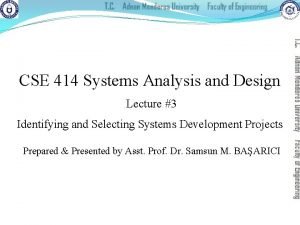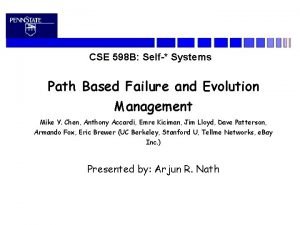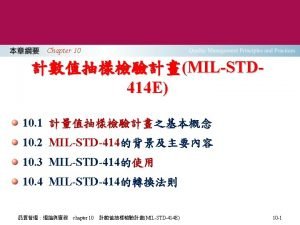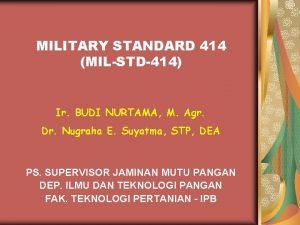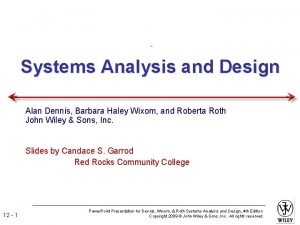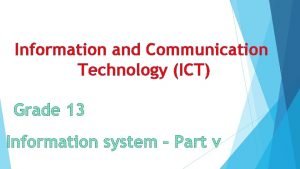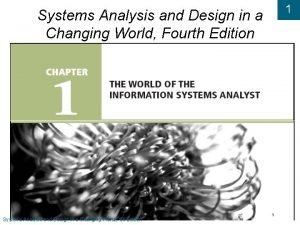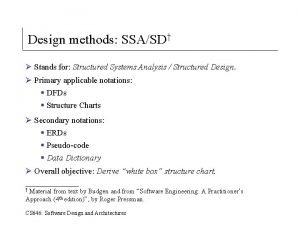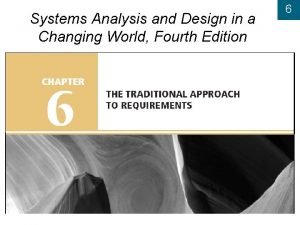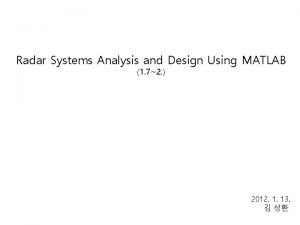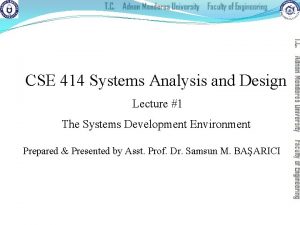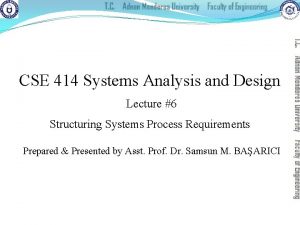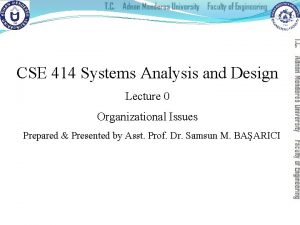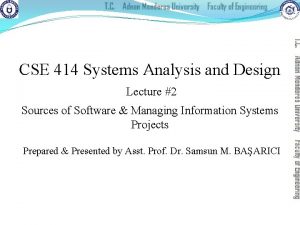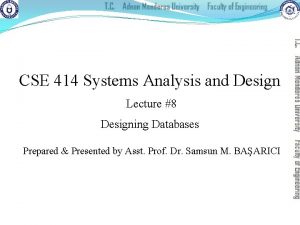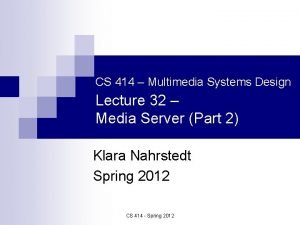CSE 414 Systems Analysis and Design Lecture 7



























































- Slides: 59

CSE 414 Systems Analysis and Design Lecture #7 Structuring Systems Data Requirements Prepared & Presented by Asst. Prof. Dr. Samsun M. BAŞARICI

Learning Objectives üExplain the role of conceptual data modeling in the overall analysis and design of an information system. üDescribe the information gathering process for conceptual data modeling. üDescribe how to represent an entity-relationship model and be able to define the terms: entity type, attribute, multivalued attribute, and relationship. Lecture #7 Structuring Systems Data Requirements 2

Learning Objectives (Cont. ) üDistinguish among unary, binary, and ternary relationships as well as associative entities, providing an example of each. üDefine supertypes and subtypes, showing how to represent these entity types with ER diagramming notation. üDefine four basic types of business rules in a conceptual data model. üExplain the role of prepackaged database models (patterns) in data modeling. Lecture #7 Structuring Systems Data Requirements 3

Conceptual Data Modeling § Conceptual data modeling: a detailed model that captures the overall structure of data in an organization �Independent of any database management system (DBMS) or other implementation considerations Lecture #7 Structuring Systems Data Requirements 4

Conceptual Data Modeling (Cont. ) FIGURE 8 -1 Systems development life cycle with analysis phase highlighted Lecture #7 Structuring Systems Data Requirements 5

The Conceptual Data Modeling Process § Develop a data model for the current system. § Develop (or purchase) a new conceptual data model that includes all requirements of the new system. § In the design stage, the conceptual data model is translated into a physical design. § Project repository links all design and data modeling steps performed during SDLC. Lecture #7 Structuring Systems Data Requirements 6

Conceptual Data Modeling (Cont. ) FIGURE 8 -2 Relationship between data modeling and the SDLC Lecture #7 Structuring Systems Data Requirements 7

Deliverables and Outcome § Entity-relationship (E-R) diagram or UML class diagram � Entities (or classes) – categories of data, represented as rectangles � Relationships (or associations) – lines between the entities § Set of entries about data objects to be stored in repository project dictionary, or data modeling software � Repository links data, process, and logic models of an information system. � Data elements included in the data flow diagram (DFD) must appear in the data model and vice versa. � Each data store in a process model must relate to business objects represented in the data model. Lecture #7 Structuring Systems Data Requirements 8

FIGURE 8 -3 Sample conceptual data model Lecture #7 Structuring Systems Data Requirements 9

Gathering Information for Conceptual Data Modeling § Two perspectives on data modeling: �Top-down approach for a data model is derived from an intimate understanding of the business. �Bottom-up approach for a data model is derived by reviewing specifications and business documents. Lecture #7 Structuring Systems Data Requirements 10

Gathering Information for Conceptual Data Modeling (Cont. ) § Requirements Determination Questions for Data Modeling: �What are subjects/objects of the business? �Data entities and descriptions �What unique characteristics distinguish between subjects/objects of the same type? �Primary keys Lecture #7 Structuring Systems Data Requirements 11

Gathering Information for Conceptual Data Modeling (Cont. ) �What characteristics describe each subject/object? �Attributes and secondary keys �How do you use the data? �Security controls and user access privileges �Who knows the meaning of the data? �Over what period of time are you interested in the data? �Cardinality and time dimensions Lecture #7 Structuring Systems Data Requirements 12

Gathering Information for Conceptual Data Modeling (Cont. ) �Are all instances of each object the same? �Supertypes, subtypes, and aggregations �What events occur that imply associations between objects? �Relationships and cardinalities �Are there special circumstances that affect the way events are handled? �Integrity rules, minimum and maximum cardinalities, time dimensions Lecture #7 Structuring Systems Data Requirements 13

Introduction to Entity-Relationship (E-R) Modeling § Entity-Relationship data model (E-R model): a detailed, logical representation of the entities, associations and data elements for an organization or business area § Entity-relationship diagram (E-R diagram): a graphical representation of an E-R model Lecture #7 Structuring Systems Data Requirements 14

Introduction to E-R Modeling (Cont. ) § The E-R model is expressed in terms of: �Data entities in the business environment. �Relationships or associations among those entities. �Attributes or properties of both the entities and their relationships. Lecture #7 Structuring Systems Data Requirements 15

Introduction to E-R Modeling (Cont. ) § Entity: a person, place, object, event or concept in the user environment about which data is to be maintained § Entity type: collection of entities that share common properties or characteristics § Entity instance: single occurrence of an entity type Lecture #7 Structuring Systems Data Requirements 16

FIGURE 8 -5 Basic E-R notation Lecture #7 Structuring Systems Data Requirements 17

Naming and Defining Entity Types § An entity type name should be: �A singular noun. �Descriptive and specific to the organization. �Concise. § Event entity type should be named for the result of the event, not the activity or process of the event. Lecture #7 Structuring Systems Data Requirements 18

Naming and Defining Entity Types (Cont. ) § An entity type definition: �Includes a statement of what the unique characteristic(s) is (are) for each instance. �Makes clear what entity instances are included and not included in the entity type. �Often includes a description of when an instance of the entity type is created or deleted. Lecture #7 Structuring Systems Data Requirements 19

Naming and Defining Entity Types (Cont. ) § For some entity types the definition must specify: �When an instance might change into an instance of another entity type. �What history is to be kept about entity instances. Lecture #7 Structuring Systems Data Requirements 20

Attributes § Attribute: a named property or characteristic of an entity that is of interest to the organization �Naming an attribute: i. e. Vehicle_ID �Place its name inside the rectangle for the associated entity in the E-R diagram. Lecture #7 Structuring Systems Data Requirements 21

Naming and Defining Attributes § An attribute name is a noun and should be unique. § To make an attribute name unique and for clarity, each attribute name should follow a standard format. § Similar attributes of different entity types should use similar but distinguishing names. Lecture #7 Structuring Systems Data Requirements 22

Naming and Defining Attributes (Cont. ) § An attribute definition: �States what the attribute is and possibly why it is important. �Should make it clear what is included and what is not included. �Contains any aliases or alternative names. �States the source of values for the attribute. Lecture #7 Structuring Systems Data Requirements 23

Naming and Defining Attributes (Cont. ) § An attribute definition should indicate: �If a value for the attribute is required or optional. �If a value for the attribute may change. �Any relationships that attribute has with other attributes. Lecture #7 Structuring Systems Data Requirements 24

Candidate Keys and Identifiers § Candidate key: an attribute (or combination of attributes) that uniquely identifies each instance of an entity type § Identifier: a candidate key that has been selected as the unique, identifying characteristic for an entity type Lecture #7 Structuring Systems Data Requirements 25

Candidate Keys and Identifiers (Cont. ) § Selection rules for an identifier � � Choose a candidate key that will not change its value. Choose a candidate key that will never be null. Avoid using intelligent keys. Consider substituting single value surrogate keys for large composite keys. Lecture #7 Structuring Systems Data Requirements 26

Other Attribute Types § Multivalued attribute: an attribute that may take on more than one value for each entity instance § Repeating group: a set of two or more multivalued attributes that are logically related Lecture #7 Structuring Systems Data Requirements 27

FIGURE 8 -8 Multivalued attributes and repeating groups Lecture #7 Structuring Systems Data Requirements 28

Other Attribute Types (Cont. ) § Required attribute: an attribute that must have a value for every entity instance § Optional attribute: an attribute that may not have a value for every entity instance § Composite attribute: an attribute that has meaningful component parts § Derived attribute: an attribute whose value can be computed from related attribute values Lecture #7 Structuring Systems Data Requirements 29

Relationships § Relationship: an association between the instances of one or more entity types that is of interest to the organization § Degree: the number of entity types that participate in a relationship Lecture #7 Structuring Systems Data Requirements 30

Figure 8 -10 Relationship type and instances (a) Relationship type (Completes) (b) Relationship instances Lecture #7 Structuring Systems Data Requirements 31

Conceptual Data Modeling and the E-R Model § Unary relationship: a relationship between the instances of one entity type �Also called a recursive relationship § Binary relationship: a relationship between instances of two entity types �Most common type of relationship encountered in data modeling § Ternary relationship: a simultaneous relationship among instances of three entity types Lecture #7 Structuring Systems Data Requirements 32

Cardinalities in Relationships § Cardinality: the number of instances of entity B that can (or must) be associated with each instance of entity A § Minimum Cardinality �The minimum number of instances of entity B that may be associated with each instance of entity A § Maximum Cardinality �The maximum number of instances of entity B that may be associated with each instance of entity A Lecture #7 Structuring Systems Data Requirements 33

Unary relationships FIGURE 8 -11 Examples of relationships of different degrees Binary relationships Ternary relationships Lecture #7 Structuring Systems Data Requirements 34

Cardinalities in Relationships (Cont. ) § Mandatory vs. Optional Cardinalities �Specifies whether an instance must exist or can be absent in the relationship Lecture #7 Structuring Systems Data Requirements 35

FIGURE 8 -14 Examples of cardinality constraints (a) Mandatory cardinalities (b) One optional, one mandatory cardinality (c) Optional cardinalities Lecture #7 Structuring Systems Data Requirements 36

Naming and Defining Relationships § A relationship name is a verb phrase; avoid vague names. § A relationship definition: �Explains what action is to be taken and possibly why it is important. �Gives examples to clarify the action. Lecture #7 Structuring Systems Data Requirements 37

Naming and Defining Relationships (Cont. ) § A relationship definition should: �Explain any optional participation. �Explain the reason for any explicit maximum cardinality other than many. �Explain any restrictions on participation in the relationship. �Explain the extent of history that is kept in the relationship. �Explain whether an entity instance involved in a relationship instance can transfer participation to another relationship instance. Lecture #7 Structuring Systems Data Requirements 38

Associative Entities § Associative Entity: an entity type that associates the instances of one or more entity types and contains attributes that are peculiar to the relationship between those entity instances �Sometimes called a gerund § The data modeler chooses to model the relationship as an entity type. Lecture #7 Structuring Systems Data Requirements 39

FIGURE 8 -15 An associative entity Attribute on a relationship An associative entity (CERTIFICATE) An associative entity using Microsoft Visio® Lecture #7 Structuring Systems Data Requirements 40

Summary of Conceptual Data Modeling with E-R Diagrams § The purpose of E-R diagramming is to capture the richest possible understanding of the meaning of the data necessary for an information system or organization. Lecture #7 Structuring Systems Data Requirements 41

Representing Supertypes and Subtypes § Subtype: a subgrouping of the entities in an entity type �Is meaningful to the organization �Shares common attributes or relationships distinct from other subgroupings § Supertype: a generic entity type that has a relationship with one or more subtypes Lecture #7 Structuring Systems Data Requirements 42

Figure 8 -18 Supertype/subtype relationships in a hospital Lecture #7 Structuring Systems Data Requirements 43

Representing Supertypes and Subtypes (Cont. ) § Business Rules for Supertype/subtype Relationships: �Total specialization specifies that each entity instance of the supertype must be a member of some subtype in the relationship. �Partial specialization specifies that an entity instance of the supertype does not have to belong to any subtype, and may or may not be an instance of one of the subtypes. Lecture #7 Structuring Systems Data Requirements 44

Representing Supertypes and Subtypes (Cont. ) �Disjoint rule specifies that if an entity instance of the supertype is a member of one subtype, it cannot simultaneously be a member of any other subtype. �Overlap rule specifies that an entity instance can simultaneously be a member of two (or more) subtypes. Lecture #7 Structuring Systems Data Requirements 45

FIGURE 8 -19 Example of supertype/subtype hierarchy Lecture #7 Structuring Systems Data Requirements 46

Business Rules § Business rules: specifications that preserve the integrity of the logical data model �Captured during requirements determination �Stored in CASE repository as they are documented Lecture #7 Structuring Systems Data Requirements 47

Business Rules (Cont. ) § Four basic types of business rules are: �Entity integrity: unique, non-null identifiers �Referential integrity constraints: rules governing relationships between entity types �Domains: constraints on valid values for attributes �Triggering operations: other business rules that protect the validity of attribute values Lecture #7 Structuring Systems Data Requirements 48

Domains § § Domain: the set of all data types and values that an attribute can assume Several advantages � � � Verify that the values for an attribute are valid Ensure that various data manipulation operations are logical Help conserve effort in describing attribute characteristics Lecture #7 Structuring Systems Data Requirements 49

Triggering Operations § Trigger: an assertion or rule that governs the validity of data manipulation operations such as insert, update and delete Lecture #7 Structuring Systems Data Requirements 50

Triggering Operations (Cont. ) § Includes the following components: �User rule: statement of the business rule to be enforced by the trigger �Event: data manipulation operation that initiates the operation �Entity Name: name of entity being accessed or modified �Condition: condition that causes the operation to be triggered �Action: action taken when the operation is triggered Lecture #7 Structuring Systems Data Requirements 51

Role of Packaged Conceptual Data Models – Database Patterns § Packaged data models provide generic models that can be customized for a particular organization’s business rules. § Universal data models are templates for �one or more core subject areas such as: � Customers, products, accounts, documents �and/or core business functions such as: � Purchasing, accounting, receiving, etc. Lecture #7 Structuring Systems Data Requirements 52

Role of Packaged Conceptual Data Models – Database Patterns (Cont. ) § Industry-specific data models are designed to be used by organizations within specific industries. § These models are based on the premise that data model patterns for organizations are similar within a particular industry. Lecture #7 Structuring Systems Data Requirements 53

Benefits of Database Patterns and Packaged Data Models § Dramatically reduced implementation times and costs �Provides a starting point for asking requirements questions § Higher-quality models �Represent “best practice” data modeling techniques and data model components whose quality often exceeds that which can be achieved by internal development teams, given typical organizational pressures Lecture #7 Structuring Systems Data Requirements 54

Electronic Commerce Application: Conceptual Data Modeling § Five general categories of information were identified for Pine Valley Furniture’s Web. Store. § Next step was to define each item. § The final step was to identify the interrelationships between the four entities. Figure 8 -22 E-R diagram for the Web. Store system Lecture #7 Structuring Systems Data Requirements 55

Summary § Now you learned how to: ü Explain the role of conceptual data modeling in the overall analysis and design of an information system. ü Describe the information gathering process for conceptual data modeling. ü Describe how to represent an entity-relationship model and be able to define the terms: entity type, attribute, multivalued attribute, and relationship. Lecture #7 Structuring Systems Data Requirements 56

Summary (Cont. ) § Now you learned how to: ü Distinguish among unary, binary, and ternary relationships as well as associative entities, providing an example of each. ü Define supertypes and subtypes, showing how to represent these entity types with ER diagramming notation. ü Define four basic types of business rules in a conceptual data model. ü Explain the role of prepackaged database models (patterns) in data modeling. Lecture #7 Structuring Systems Data Requirements 57

Next Lecture Designimg Databases Lecture #7 Structuring Systems Data Requirements 58

References § Joseph S. Valacich, Joey F. George, Modern Systems Analysis and Design, 8 th Global Edition, Pearson, 2016 Lecture #7 Structuring Systems Data Requirements 59
 Cse414
Cse414 Cse 598 advanced software analysis and design
Cse 598 advanced software analysis and design 01:640:244 lecture notes - lecture 15: plat, idah, farad
01:640:244 lecture notes - lecture 15: plat, idah, farad Gcd of 414 and 662
Gcd of 414 and 662 Kendall and kendall terminology
Kendall and kendall terminology Mil-std-414
Mil-std-414 Mil std 414
Mil std 414 Mil std 414
Mil std 414 Pc 414
Pc 414 Cs 414
Cs 414 Cmsc 414
Cmsc 414 Cmsc 414
Cmsc 414 Cmsc 414
Cmsc 414 Cmsc 414
Cmsc 414 Systems analysis and design in an age of options
Systems analysis and design in an age of options System analysis
System analysis Systems analysis and design in a changing world
Systems analysis and design in a changing world Systems analysis and design in a changing world
Systems analysis and design in a changing world Systems analysis and design alan dennis
Systems analysis and design alan dennis Introduction to system analysis and design
Introduction to system analysis and design Structured systems analysis and design method
Structured systems analysis and design method Case tools are limited to systems analysis.
Case tools are limited to systems analysis. Modern systems analysis and design
Modern systems analysis and design Kendall & kendall systems analysis and design
Kendall & kendall systems analysis and design Alan dennis system analysis design
Alan dennis system analysis design Systems analysis and design alan dennis
Systems analysis and design alan dennis Systems analysis and design alan dennis
Systems analysis and design alan dennis Systems analysis and design alan dennis
Systems analysis and design alan dennis Systems analysis and design alan dennis
Systems analysis and design alan dennis Systems analysis and design alan dennis
Systems analysis and design alan dennis Systems analysis and design alan dennis
Systems analysis and design alan dennis Structured systems analysis and design method
Structured systems analysis and design method Radar systems analysis and design using matlab
Radar systems analysis and design using matlab Object-oriented systems analysis and design using uml
Object-oriented systems analysis and design using uml A modern approach to systems analysis and design
A modern approach to systems analysis and design Systems analysis and design kendall
Systems analysis and design kendall System analysis and design in a changing world
System analysis and design in a changing world Systems analysis and design in a changing world
Systems analysis and design in a changing world Systems analysis and design in a changing world
Systems analysis and design in a changing world Systems analysis and design alan dennis
Systems analysis and design alan dennis Systems analysis and design alan dennis
Systems analysis and design alan dennis Systems analysis and design alan dennis
Systems analysis and design alan dennis Modern systems analysis and design 7th edition
Modern systems analysis and design 7th edition Structured system of communication
Structured system of communication Essentials of systems analysis and design
Essentials of systems analysis and design Systems analysis and design in a changing world
Systems analysis and design in a changing world Systems analysis and design alan dennis
Systems analysis and design alan dennis List the five basic steps of ssa/sd process
List the five basic steps of ssa/sd process Systems analysis and design in a changing world
Systems analysis and design in a changing world Systems analysis and design in a changing world
Systems analysis and design in a changing world Radar system analysis and design using matlab
Radar system analysis and design using matlab System analysis and design kendall
System analysis and design kendall Design in output
Design in output Operating systems lecture notes
Operating systems lecture notes Lecture sound systems
Lecture sound systems Lecture sound systems
Lecture sound systems User interface design in system analysis and design
User interface design in system analysis and design Dialogue design in system analysis and design
Dialogue design in system analysis and design Disadvantages of structured analysis
Disadvantages of structured analysis Fact-finding techniques in system analysis and design
Fact-finding techniques in system analysis and design
